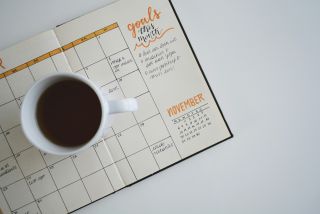Motivation
Mastering the Art of Goal Setting: Your Path to Success
Creating goals doesn't have to be difficult or boring.
Posted February 14, 2024 Reviewed by Davia Sills
Key points
- Many people think of goal-setting as a tedious and laborious process, but it doesn't have to be that way.
- It helps for individuals to start with their life purpose and create a clear vision for their life.
- Using their life purpose, they can create huge goals, which are then broken down into smaller steps.
- Having a plan to overcome obstacles and an accountability partner will help them stay on course.

Most of my clients love figuring out their passions and even dreaming of their vision for their futures. That’s the fun stuff! They get bored or stuck when it comes to setting goals. Their enthusiasm quickly fades, and they tell me they know what to do or they don’t like to plan that far ahead. They’ll say goal work is too tedious or a waste of time.
Without clear goals, how in the world are you supposed to stay on track? If you don’t know in which direction to move next, how will you stay motivated to keep going? If you don’t know how to break down a huge aim into smaller steps, how will you avoid feeling overwhelmed or distracted?
Goal setting seems like a pretty simple task. Many people think they can just do it in their heads. I hear people say all the time, “I know what my goals are! I don’t need to write down the steps.” What they don’t fully understand is how essential it is to write down the steps. First, it reduces the cognitive load of having to remember what to do. You no longer have to remember each step because you offloaded it to a schedule or planner, and now your brain is free to focus on the important things, like learning, creating, and socializing.
Second, you’re much more likely to follow through on goals you’ve written down. Our brains are more likely to encode written information into memory. When you put goals in writing, you become subconsciously aware of what you’re working towards, which helps you make decisions that move you closer to your goals (Murphy 2018). Writing down goals, in other words, helps guide and shape our behaviors.
Think Massive
Before you can get into the nitty-gritty of daily goals, you need to think big. And I mean massive.
You need to have an idea of what your life purpose is. A life purpose helps you in two ways. It increases grit, and it gives direction for your goals. When you know your overarching reason for doing the mundane small stuff, you’re more likely to put in effort and persevere. If you can trace a small daily goal or task all the way back up to your life purpose, you’re going to want to do it. And when you know what your life purpose is, you’re better able to design your goals. Your life purpose is the overarching idea of what you’re trying to achieve, and the smaller goals are all the steps you need to take to get there. Let’s pretend that you decide your life purpose is to have financial freedom.
Now Think Huge
Huge goals are the catalyst for action. Huge goals are when we take our life purpose and set goals five years down the road that will bring us closer to that purpose. These huge goals might even seem impossible, and that’s kind of the point. We want them to be aspirational, not necessarily realistic.
Thinking huge is the fun part of goal setting. Thinking huge gets us in touch with our dreams and lets us imagine a life full of possibility. Whatever you want for your life, you get to identify it and put words to it. If your life purpose is to have financial freedom, your huge goals might include traveling the world, the ability to work remotely, and having friends on every continent.
Get Direction
To get clear direction, I take one huge goal at a time and break it down, first into a goal for each year. Since one of your huge goals is the ability to work remotely, you make a yearly goal of finding a job that doesn’t require in-office work. Your yearly goal gives definition to your huge goal (and it can even be traced all the way back to your life purpose of having financial freedom).
We then take our yearly goals and break them down into quarterly, monthly, and weekly goals, getting more specific with each. Our goal sheet ends with a to-do list, which is a list of daily steps that we can check off as we go. And the beauty is that we can look at our daily to-do list and follow it all the way back up the goal sheet to see how it’ll help us achieve the main thing we want for our lives.
Identify Obstacles
Every good goal sheet includes a plan for dealing with barriers. We don’t want to assume that things will go smoothly; otherwise, we’ll just become frustrated when they don’t and will be more likely to quit. Instead, try to anticipate what might go wrong along the way and decide ahead of time how you’ll deal with those things. We don’t want to do this for our life purpose or huge goals, though; we want to anticipate obstacles for the more immediate steps, like our monthly and weekly goals.
For the individual with the yearly goal of finding a remote position, they might have a monthly goal of increasing their connections on LinkedIn and a weekly goal of commenting on a post of an industry leader in their chosen field. Perhaps they identify time as an obstacle for each goal since they know they have a lot going on right now. Coming up with a plan on how to best manage their time and ways to structure their schedule for the coming weeks will increase their odds of still meeting their goals despite their busy calendar.
Be Adaptable
A good goal sheet is a working document. This allows us to shift things along the way. Life is going to happen, and that might mean we have to move one of our to-do items to the next day or push back a monthly goal to a quarterly goal. This is to be expected.
If we’re rigid in our goal setting, we’ll feel like failures. We’re going to have days where we’re too exhausted, we get the flu, our pet gets injured, or our family member is going through a difficult time and needs our attention. It’s inevitable. But we need to be able to make the necessary adjustments and get back on course. If we’re inflexible with our goals, we’ll decide we’re too far off course after recovering from the flu and throw the whole thing out.
Instead, make your goal sheet easy to change. I use an Excel spreadsheet so I can easily move things around and edit. I have clients who use whiteboards and others who rewrite their goals each week. Find a system that works for you, and get in the habit of making updates along the way.
Stay On Course
Goal setting can be laborious and tedious. It helps if you have an accountability partner or a coach to keep you on track. Find someone who won’t let you off the hook too easily and get started. Your life purpose doesn’t have to be out of reach.
References
Keita Umejima, Takuya Ibaraki, Takahiro Yamazaki, Kuniyoshi L. Sakai. Paper Notebooks vs. Mobile Devices: Brain Activation Differences During Memory Retrieval. Frontiers in Behavioral Neuroscience, 2021; 15 DOI: 10.3389/fnbeh.2021.634158
Murphy, M. 2018. “Neuroscience Explains Why You Need to Write Down Your Goals if You Actually Want to Achieve Them.” Forbes, April 15. https://www.forbes.com/sites/markmurphy/2018/04/15/neuroscience-explains-why-you-need-to-write-down-your-goals-if-you-actually-want-to-achieve-them/?sh=69509f417905.




